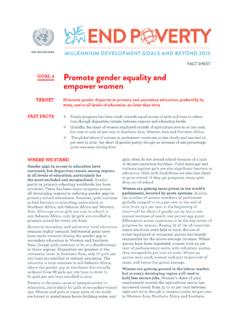Transcription of China policies to promote local production of ...
1 China policies to promote local production of pharmaceuticalproducts and protect public healthChina policies to promote local production of pharmaceutical products and protect public healthCMYKP antone EC Corporate BlueBlack Logo (horizontal)Positive versionsThe horizontal logo is a substitute of the standard logo in cases when the applicability of the standard logo is constrained due to space or aesthetic reasons. The cases identified so far for the use of the horizontal logo are: Press Room backdrops, signposting of buildings, e-mail newsletters, Facebook timeline as part of the top CMYK horizontal logo is designed for small communication media such as mobile web, electronic newsletters, Facebook pages, PowerPoint presentations, Pantone Reflex Blue and Black versions of the horizontal logo are designed for specific printing on very small communication media such as pens.
2 These logos have to be used with colours in 100 % to ensure all elements of the logo are clearly Property and TradeFinancingTechnologyTransferImprovin g AccessR&D, InnovationMonitoring and ReportingISBN 978 92 4 151217 6 Intellectual Property and TradeFinancingTechnology TransferR&D, InnovationMonitoring and ReportingChina policies to promote local production of pharmaceutical products and protect public healthChina policies to promote local production of pharmaceutical products and protect public health ISBN 978-92-4-151217-6 World Health Organization 2017 Some rights reserved. This work is available under the Creative Commons Attribution-NonCommercial-ShareAlike IGO licence (CC BY-NC-SA IGO; ). Under the terms of this licence, you may copy, redistribute and adapt the work for non-commercial purposes, provided the work is appropriately cited, as indicated below.
3 In any use of this work, there should be no suggestion that WHO endorses any specific organization, products or services. The use of the WHO logo is not permitted. If you adapt the work, then you must license your work under the same or equivalent Creative Commons licence. If you create a translation of this work, you should add the following disclaimer along with the suggested citation: This translation was not created by the World Health Organization (WHO). WHO is not responsible for the content or accuracy of this translation. The original English edition shall be the binding and authentic edition .Any mediation relating to disputes arising under the licence shall be conducted in accordance with the mediation rules of the World Intellectual Property citation. China policies to promote local production of pharmaceutical products and protect public health.
4 Geneva: World Health Organization; 2017. Licence: CC BY-NC-SA (CIP) data. CIP data are available at , rights and licensing. To purchase WHO publications, see To submit requests for commercial use and queries on rights and licensing, see materials. If you wish to reuse material from this work that is attributed to a third party, such as tables, figures or images, it is your responsibility to determine whether permission is needed for that reuse and to obtain permission from the copyright holder. The risk of claims resulting from infringement of any third-party-owned component in the work rests solely with the disclaimers. The designations employed and the presentation of the material in this publication do not imply the expression of any opinion whatsoever on the part of WHO concerning the legal status of any country, territory, city or area or of its authorities, or concerning the delimitation of its frontiers or boundaries.
5 Dotted and dashed lines on maps represent approximate border lines for which there may not yet be full agreement. The mention of specific companies or of certain manufacturers products does not imply that they are endorsed or recommended by WHO in preference to others of a similar nature that are not mentioned. Errors and omissions excepted, the names of proprietary products are distinguished by initial capital reasonable precautions have been taken by WHO to verify the information contained in this publication. However, the published material is being distributed without warranty of any kind, either expressed or implied. The responsibility for the interpretation and use of the material lies with the reader. In no event shall WHO be liable for damages arising from its use. Editing and design by In s Communication and Acronyms ivAcknowledgements viExecutive summary 1I.
6 Overview 4II. Regulatory reform 8 III. China s pharmaceutical Sector 16IV. Distribution 27V. Innovation and technology transfer 29VI. The Role of Intellectual Property 32 VII. Competition Law 34 VIII. Modelling for local production and transfer of technology 35 Appendix 1: Questions for interviewees in China regarding country models for the promotion of the pharmaceutical production sector 40 Appendix 2: List of interviewee organizations 45 Appendix 3.
7 Project Concept Note 46 Annex 1 List of Government Departments/ Agencies of Interest 49ivAbbreviations and AcronymsANDA abbreviated new drug applicationAPIactive pharmaceutical ingredientBMIbasic medical insuranceCDEC enter for Drug Evaluation CDFAC hina Food and Drug Administration ChPChinese PharmacopeiaCPCC hinese Pharmacopeia Commission CROcontract research organization EMLessential medicines listEMAE uropean Medicines Agency FDIforeign direct investment FPPfinished pharmaceutical product GMPgood manufacturing practice GSPAG lobal Strategy and Plan of ActionHIChigh-income countryIPintellectual property MAHmarketing authorization holder MNCmultinational corporation MOFCOMM inistry of Commerce of the People s Republic of ChinaNDAnew drug applicationNDRCN ational Development and Reform CommissionMPPM edicines Patent PoolMOHM inistry of Health NHFPCN ational Health and Family Planning Commission OTCover-the-counter PHIP ublic Health, Innovation and Intellectual PropertyPRCP eople s Republic of ChinaR&Dresearch and development SAICS tate Administration for Industry and CommerceSIPOS tate Intellectual Property OfficeSOEstate-owned enterprise SEZspecial economic zonevTCMtraditional Chinese medicineUHCuniversal health careUS FDAU nited States Food and Drug Administration US PTOU nited States Patent and Trademark Office USPU nited States Pharmacopeia Convention VATvalue-added taxWHOW orld Health OrganizationWTOW orld Trade OrganizationviCHINA REPORT AcknowledgementsThis study and report were made possible by the generous support of the European Commission, through the World Health Organization (WHO)
8 local production project Improving access to medical products in developing countries through capacity building for local production and related technology transfer. This report was prepared by Professor Frederick Abbott, WHO consultant. This report benefits from information gathered in connection with a visit to China in June 2016 by Professor Abbott and Dr Jicui Dong, Programme Manager for local production , WHO Department of Essential Medicines and Health Products (EMP). We thank our hosts at the China Food and Drug Administration (CFDA), China s National Health and Family Planning Commission (NHFPC), the State Administration of Traditional Chinese Medicine (SATCM), the China Chamber of Commerce for Import & Export of Medicines and Health Products (CCCMHPIE), the Xiyuan Hospital of the China Academy of Chinese Medical Sciences and the Gates Foundation China Office.
9 Particular thanks are owed to Dr Xu Ming, Vice President of CCCMHPIE for providing an overview of the Chinese pharmaceutical sector and organizing discussions with representatives of the Chinese pharmaceutical industry; Dr Sun Yang, Deputy Director-General of the Department of Drug Policy and Essential Medicines at NHFPC for providing a detailed overview of China s national health care structure; Dr Zhu Haidong, Deputy Director-General of the International Cooperation Department at SATCM for furnishing information on traditional Chinese medicine, and; Mr Wang Xiangyu, Director of the Division of International Organizations at CFDA for providing information relating to regulatory matters. Additional thanks are owed to Dr LIU Yue, Director of the Department of International Cooperation at NHFPC, Ms Chen Yuan, Program Officer at the Bill & Melinda Gates Foundation China Office, as well other Chinese colleagues and representatives from the Chinese pharmaceutical industry who took part in interviews and thanks to the China Office of WHO for organizing and coordinating local arrangements for the discussions in China , with particular thanks to Ms Noura Maalaoui, Technical Officer, Mr Fabio Scani, Coordinator and Dr Bernhard Schwartlander, WHO Representative at the China Office.
10 This report was initiated under the direction of Dr Zafar Mirza, former Coordinator of the Programme on Public Health, Innovation and Intellectual Property, EMP. At the WHO, this work was led by Dr Jicui Dong, Programme Manager for local production , EMP. Dr Dong provided valuable contributions to the study and her review comments have enriched the document. Special thanks to Dr Suzanne Hill, Director of the Department of Essential Medicines and Health Products, for her support throughout the production of the summaryAs part of a series of studies and reports regarding local production and transfer of technology in the pharmaceutical sector, the Programme on Public Health, Innovation and Intellectual Property in the World Health Organization (WHO) Department of Essential Medicines and Health Products (EMP) commissioned this study with respect to the pharmaceutical sector in the People s Republic of China ( China ).
















